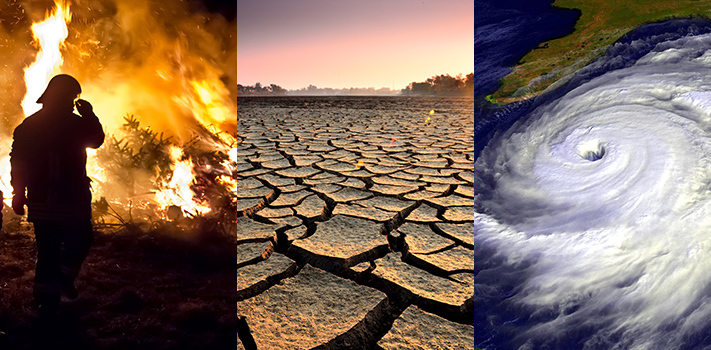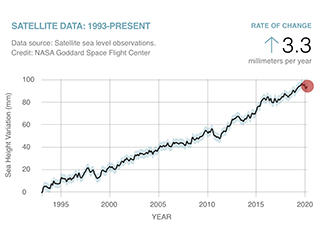What Are The Consequences Of Climate Change

The potential future effects of global climate change include more frequent wildfires, longer periods of drought in some regions and an increase in the number, duration and intensity of tropical storms. Credit: Left - Mellimage/Shutterstock.com, middle - Montree Hanlue/Shutterstock.com.
› en español
Global climatic change has already had observable furnishings on the environment. Glaciers have shrunk, ice on rivers and lakes is breaking up earlier, found and animal ranges have shifted and trees are flowering sooner.
Effects that scientists had predicted in the by would consequence from global climatic change are now occurring: loss of bounding main ice, accelerated sea level rising and longer, more intense heat waves.
Taken equally a whole, the range of published evidence indicates that the internet damage costs of climate change are probable to be significant and to increase over time.
Scientists take high confidence that global temperatures will continue to ascension for decades to come, largely due to greenhouse gases produced past human activities. The Intergovernmental Panel on Climate Change (IPCC), which includes more than 1,300 scientists from the United States and other countries, forecasts a temperature ascension of ii.five to 10 degrees Fahrenheit over the next century.
According to the IPCC, the extent of climatic change effects on private regions will vary over time and with the ability of different societal and environmental systems to mitigate or arrange to change.
The IPCC predicts that increases in global hateful temperature of less than ane.8 to 5.4 degrees Fahrenheit (ane to 3 degrees Celsius) above 1990 levels will produce benign impacts in some regions and harmful ones in others. Net almanac costs will increase over time as global temperatures increase.
"Taken as a whole," the IPCC states, "the range of published evidence indicates that the net damage costs of climate change are probable to exist pregnant and to increase over time." one-2
Future Effects
Some of the long-term furnishings of global climate change in the United states of america are as follows, according to the Third and Quaternary National Climate Assessment Reports:
Change Will Continue Through This Century and Beyond
-
Global climate is projected to continue to change over this century and beyond. The magnitude of climatic change beyond the adjacent few decades depends primarily on the amount of estrus-trapping gases emitted globally, and how sensitive the World's climate is to those emissions.
Temperatures Volition Continue to Rise
-
Considering human being-induced warming is superimposed on a naturally varying climate, the temperature ascent has not been, and will not be, uniform or smooth across the country or over time.
Frost-gratis Flavour (and Growing Season) will Lengthen
-
The length of the frost-free season (and the corresponding growing season) has been increasing nationally since the 1980s, with the largest increases occurring in the western United States, affecting ecosystems and agronomics. Across the United States, the growing season is projected to continue to lengthen.
In a future in which heat-trapping gas emissions continue to abound, increases of a month or more in the lengths of the frost-free and growing seasons are projected across most of the U.South. by the end of the century, with slightly smaller increases in the northern Cracking Plains. The largest increases in the frost-free season (more than viii weeks) are projected for the western U.S., particularly in high elevation and coastal areas. The increases will be considerably smaller if rut-trapping gas emissions are reduced.
Changes in Precipitation Patterns
-
Boilerplate U.S. atmospheric precipitation has increased since 1900, simply some areas take had increases greater than the national average, and some areas have had decreases. More than winter and spring precipitation is projected for the northern United States, and less for the Southwest, over this century.
Projections of hereafter climate over the U.S. suggest that the recent trend towards increased heavy atmospheric precipitation events volition keep. This trend is projected to occur fifty-fifty in regions where total precipitation is expected to decrease, such as the Southwest.
More Droughts and Heat Waves
-
Droughts in the Southwest and oestrus waves (periods of abnormally hot atmospheric condition lasting days to weeks) everywhere are projected to go more intense, and cold waves less intense everywhere.
Summer temperatures are projected to continue ascent, and a reduction of soil moisture, which exacerbates heat waves, is projected for much of the western and central U.S. in summer. Past the terminate of this century, what have been once-in-20-year extreme heat days (1-day events) are projected to occur every two or 3 years over most of the nation.
Hurricanes Will Get Stronger and More than Intense
-
The intensity, frequency and duration of North Atlantic hurricanes, likewise as the frequency of the strongest (Category 4 and five) hurricanes, have all increased since the early on 1980s. The relative contributions of human being and natural causes to these increases are yet uncertain. Hurricane-associated storm intensity and rainfall rates are projected to increment as the climate continues to warm.
Ocean Level Will Ascent 1-8 feet by 2100
-
Global ocean level has risen by about 8 inches since reliable record keeping began in 1880. It is projected to rise some other 1 to 8 feet past 2100. This is the event of added water from melting land water ice and the expansion of seawater as it warms.
In the next several decades, storm surges and loftier tides could combine with ocean level rise and state subsidence to further increase flooding in many regions. Sea level rise will continue past 2100 because the oceans take a very long fourth dimension to respond to warmer weather at the Globe's surface. Body of water waters volition therefore continue to warm and sea level will keep to rise for many centuries at rates equal to or college than those of the current century.
Arctic Likely to Go Water ice-Gratis
-
The Arctic Ocean is expected to go essentially water ice free in summer before mid-century.
U.S. Regional Furnishings
Below are some of the impacts that are currently visible throughout the U.South. and will go on to affect these regions, according to the Tertiary3 and Fourthiv National Climate Assessment Reports, released by the U.S. Global Change Research Plan:
Northeast. Oestrus waves, heavy downpours and ocean level rising pose growing challenges to many aspects of life in the Northeast. Infrastructure, agronomics, fisheries and ecosystems will be increasingly compromised. Many states and cities are beginning to incorporate climate change into their planning.
Northwest. Changes in the timing of streamflow reduce h2o supplies for competing demands. Body of water level rise, erosion, overflowing, risks to infrastructure and increasing ocean acidity pose major threats. Increasing wildfire, insect outbreaks and tree diseases are causing widespread tree dice-off.
Southeast. Body of water level rise poses widespread and standing threats to the region'due south economy and environment. Extreme heat will touch health, energy, agriculture and more. Decreased water availability will accept economic and environmental impacts.
Midwest. Farthermost oestrus, heavy downpours and flooding will affect infrastructure, health, agronomics, forestry, transportation, air and water quality, and more. Climate change volition also exacerbate a range of risks to the Great Lakes.
Southwest. Increased heat, drought and insect outbreaks, all linked to climate modify, take increased wildfires. Declining h2o supplies, reduced agricultural yields, health impacts in cities due to estrus, and flooding and erosion in littoral areas are additional concerns.
References
- IPCC 2007, Summary for Policymakers, in Climatic change 2007: Impacts, Adaptation and Vulnerability. Contribution of Working Grouping II to the 4th Assessment Written report of the Intergovernmental Panel on Climate Change, Cambridge Academy Press, Cambridge, U.k., p. 17.
- IPCC, 2013: Summary for Policymakers. In: Climatic change 2013: The Physical Scientific discipline Ground. Contribution of Working Group I to the 5th Assessment Study of the Intergovernmental Panel on Climate change [Stocker, T.F., D. Qin, G.-K. Plattner, Thou. Tignor, S.1000. Allen, J. Boschung, A. Nauels, Y. Xia, V. Bex and P.Chiliad. Midgley (eds.)]. Cambridge University Press, Cambridge, United Kingdom and New York, NY, The states.
- USGCRP 2014, Third Climate Assessment.
- USGCRP 2017, Fourth Climate Assessment.
Source: https://climate.nasa.gov/effects/
Posted by: arcewrianded.blogspot.com



0 Response to "What Are The Consequences Of Climate Change"
Post a Comment